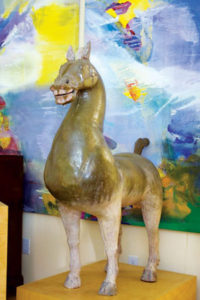 Charlie inquired about a gorgeous Chinese ceramic horse with the look of the ancient Han Dynasty (206 BCE-220 CE) warhorse. See it standing tall and four square with the dramatic barrel chest. Ceramic pieces like Charlie’s from the Han Dynasty, funerary sculpture, we call “mingqi.” They came in forms of people, soldiers, servants, animals, pots, bowls and more. Loved ones packed important people’s tombs with these to provide the spirit, which stayed here on the planet, with the necessities to maintain a certain lifestyle. The soul, of course, traveled on, with such pottery unneeded.
Charlie inquired about a gorgeous Chinese ceramic horse with the look of the ancient Han Dynasty (206 BCE-220 CE) warhorse. See it standing tall and four square with the dramatic barrel chest. Ceramic pieces like Charlie’s from the Han Dynasty, funerary sculpture, we call “mingqi.” They came in forms of people, soldiers, servants, animals, pots, bowls and more. Loved ones packed important people’s tombs with these to provide the spirit, which stayed here on the planet, with the necessities to maintain a certain lifestyle. The soul, of course, traveled on, with such pottery unneeded.
The higher the official rank of the deceased, the more statuary in the tomb and the bigger the tomb. The capacity and scale determined by the court and government of ancient China. More and more tomb statuary came on the market because of construction in China, and they dug up once-sacred sites. Because a good Han Dynasty horse fetches $2,000 or more fakes do abound.
How are these terracotta figures faked?
The myriad techniques include the assemblage of a complete figure out of the broken parts of several other mismatched ancient pieces. Another fakery technique involves taking an unglazed part of one piece then assembling newly thrown parts around it. I say the unglazed piece, because the most reliable way to test terracotta figures for age is with the scientific help of a TL (thermoluminescence) test. Samples for the test are taken from the unglazed portion of a sculpture.
Another fakery trick reqyures a reversal of common sense. No one bothers to repair a reproduction. Thus if a reproduction shows a repair, it must be authentic! This follows the adage that a repair indicates a good sign of authenticity. This supposition may well work on old Persian carpets, but not on Han, Sui (581-618 CE) or Tang (618-907) Dynasty sculptures. And a TL test is expensive, at $500 to $1,000 per piece.
What do I look for to see if Charlie’s horse is ancient?
First, ancient things feel ancient, especially if you assume they were once buried. You’ll feel no sharp edges and it won’t appear perfect. The glaze, over time, through changes in humidity and temperature, develops a “crackle,” like a hard-boiled eggshell when cracked.
Second, 1,000-plus-year-old clay smells different when moistened. If you press a sponge to an unglazed area, it should absorb moisture faster than modern terracotta, because we fire less porous modern terracotta at a hotter level. A damp sponge will also reveal the non-absorbent area of a glued repair.
Finally, consider the look of the figure itself with an understanding of the symbolism of the object portrayed. Let’s look at what the horse meant to ancient China and see if Charlie’s horse lives up to this type of grandeur.
Chinese Ceramic Horse Symbolism
Ancient Chinese saw horses as “the steeds of heaven,” a sign of political power, masculinity and military might. In fact, China became the most powerful nation in the world by the 10th century CE. Of course, all Chinese noblemen and soldiers were expected to be expert horsemen. The size of the funereal horse indicated the power of the deceased, and Charlie’s horse stands a good 30 inches, a nice size. We see the tail lifted, indicating energy and movement. The horse also shows one of the three typical colors of glaze called “sancai.” Charlie’s horse is glazed green, the other two important Tang glazes are beige and camel brown.
Do I think Charlie’s horse a reproduction? Sadly, I can’t say without feeling and lifting the piece, which today’s practice of social distancing precludes. I don’t know where or how Charlie purchased this piece, but if he purchased it online or through an online auction, one of the dangers is you can’t use your other four senses, only your eyes. I tell more by the feel of something than the look sometimes. Let’s say if Charlie’s piece is unrepaired, and authentic, I put a value of $3,000 or more on this Han horse.
Dear Elizabeth, Some years ago I inherited a small horse figurine from a member of Duke Medical School faculty. He told me that the figurine was Han Dynasty. Since I am now almost eighty years old I’m trying to sell things that I don’t think anyone in my family would appreciate. How can I tell if this figurine is, in fact, Han Dynasty and where can I reliably see if there is a market for it. Dr. Peele also left me a collection of netsukes for which I also want to find a market. I would appreciate any help you might give to me. Thank you in advance, John D. Welch